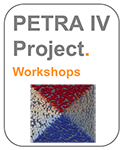Speaker
Prof.
Gerd Schoenhense
(University of Mainz, Inst fuer Physik)
Description
Electronic bandstructure, topology of the Fermi surface and the Fermi velocity distribution vF(kF) are key factors in design of materials. They determine the electronic and transport properties and thermodynamics of the electron system and are of high interest for the development of electronic devices. In this talk a novel method (termed k-microscopy) will be presented that has the potential to measure the full electronic structure in a single experiment. This opens the path towards the “complete” photoemission experiment for surfaces and solids, adopting a concept described by Kessler [1] for photoionization of free atoms. k-microscopy is based on high-resolution imaging of the Fourier plane of a cathode lens, with (kx,ky) exceeding the first Brillouin zone. Time-of-flight (ToF) recording of the binding energy EB establishes maximal parallelization. Tunable soft X-rays allow variation of kz via direct transitions to free-electron-like final states. This combination yields 10^8 resolved data points of the 4D spectral density function I(EB,kx,ky,kz) which contains the full information on the electronic structure. First measurements for the prototypical high-Z bcc metal tungsten [2] revealed the full bulk electronic structure, as well as a time-reversal invariant surface state with Dirac-like dispersion and spin texture, measured by an imaging spin filter. For this approach a suitable time structure of the photon pulses is crucial.
[1] J. Kessler, Comments Atom. Mol. Phys. 10, 47 (1981)
[2] K. Medjanik et al., Nature Materials in print, DOI 10.1038/NMAT4875 (2017)
Author
Prof.
Gerd Schoenhense
(University of Mainz, Inst fuer Physik)

